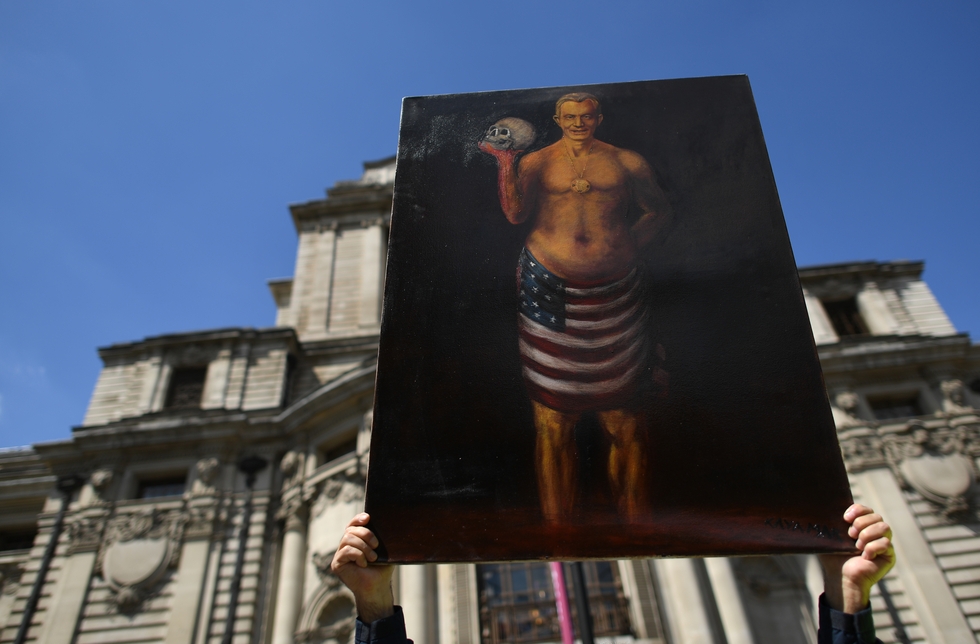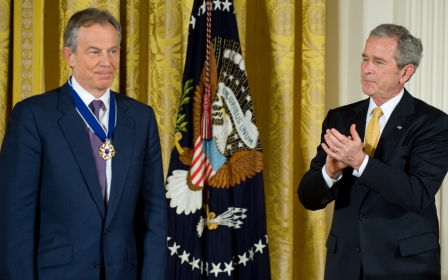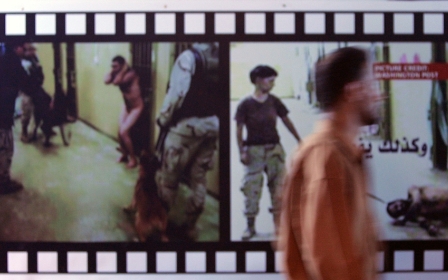Chilcot report suggests Blair made early push for regime change in Iraq

Tony Blair took the initiative in urging George W. Bush to plan for regime change in Iraq, secret UK government papers reveal.
Britain’s former prime minister is usually described as Bush’s junior partner in the attack on Saddam Hussein’s Iraq, anxious to stand shoulder to shoulder with whatever the US president decided.
But Whitehall documents which the Chilcot inquiry persuaded the Cameron government to declassify reveal that Blair played a far more significant role. He pressed the Americans to remove Saddam Hussein from power without knowing the White House was thinking along similar lines.
The Chilcot inquiry’s main findings were extensively reported when they came out in early July. But the dramatic political upheaval which led to an unexpectedly swift change of prime minister a few days later diverted attention from the trove of secret papers which reveal how Bush and Blair plotted to topple Saddam in the worst traditions of the long history of American and British intervention in the Middle East
In a note from Blair to Bush headed "TOP SECRET - Personal, UK/US Eyes Only," and sent on 4 December 2001, the prime minister wrote: “At present international opinion would be reluctant, outside the US/UK, to support immediate military action, though for sure people want to be rid of Saddam. So we need a strategy for regime change that builds over time.” (Chilcot Report. Executive Summary. paragraph 57, footnote 17) The Prime Minister suggested the US and UK mount covert operations with Iraqi opposition groups to prepare for an uprising and then take military action when the rebellion occurs.
His recommendation was made a few days after US air support and special forces on the ground in Afghanistan had toppled the Taliban. Apparently feeling triumphant, Blair suggested to Bush that if the US and UK provided humanitarian aid to Afghanistan. “We will not just have won militarily but morally... In particular we shall have given regime change a good name which will help us in the argument over Iraq.” Chilcot says (paragraph 62) that when Blair made this case the British government did not know that Bush had already asked the Pentagon to prepare options for removing Saddam by force.
As military planning advanced over the next 12 months the secret documents disclose the scenarios which the British government expected to unfold in Iraq once an attack was launched.
A paper prepared by the Foreign Office’s Directorate for Strategy and Innovation on 26 September 2002 (Chilcot executive summary, paragraph 626, footnote 220) suggested Saddam might be assassinated or he might step down and appoint a puppet president. There might be a military coup by a leading insider from the army or security (mukhabarat). A third scenario was a series of popular uprisings as US forces advanced on Baghdad. The fourth scenario was Saddam would remain in charge until the last minute before US forces took control of Baghdad.
Given that regime change was Blair and Bush’s central goal in Iraq, the documents show a remarkable lack of accurate predictions of what would follow. The Foreign Office scenario paper failed to see that Sunni and Shia differences would come to play a major role in Iraqi politics if the Saddam regime was toppled. They expected a Sunni leader to take power. “It is not clear whether religion would be an effective rallying-point for a post-Saddam administration,” the paper said, though it assumed, wrongly, that Shia religious figures “could play an important part in legitimising any new system, if they accepted Sunni political leadership”.
Jonathan Powell, Tony Blair’s chief of staff, scribbled on his copy of the paper: “fairly useless”. It was nine months since the Taliban had been removed from power in Afghanistan, and Powell wrote a few sentences in the margin of his copy, recommending that officials should try to identify an Iraqi Hamid Karzai, the US-backed post-Taliban president, to run the country and come up with a way of stopping a “terrible bloodbath of revenge after Saddam goes. Traditional in Iraq after coups.”
Orientalist assumptions
In assuming that Sunnis and Shias had ancestral grievances which were bound to explode in violence, Powell’s prediction showed the classic anti-Arab prejudices known as Orientalism.
Some Sunni engineers, architects and academics were murdered in unexplained circumstances in 2003 and 2004 and there were suspicions that their killers targeted them as symbols of the old regime. But there was no sectarian bloodbath in the immediate aftermath of Saddam’s fall. Sunni-Shia violence only developed from 2005 onwards after al-Qaeda penetrated Iraq in a major way and switched its focus from attacking the Americans to killing Shias in order to provoke a civil war.
In a memo of 13 December 2002, the Ministry of Defence’s Strategic Planning Group made the same mistaken prediction as Powell when it warned of the “potential for inter-ethnic revenge” (Exec Summary 626, footnote 218).
At least British officials did not fall for the US neocon notion that Iraqis would welcome US and UK invading forces with flowers. Some predicted that Iraqi satisfaction at being liberated from Saddam would not last long and there might be resentment at a Western occupation. On 10 March, 2002 a paper prepared by the FCO’s Directorate of Strategy and Innovation warned that “We should also expect considerable anti-Western sentiment among a population that has experienced ten years of sanctions.”
But officials failed to foresee one of the main outcomes of the occupation, namely that Iraqi nationalists, Shia as well as Sunni, would take up arms against US and UK forces. This happened within weeks of the toppling of Saddam and long before al-Qaida infiltrated Iraq. In Basra it eventually led to a British retreat in the face of Shia militia attacks, first from the city centre to the airport, and then out of the country altogether.
Ironically, one of the few people who mentioned resistance was Tony Blair. In his notorious “I will be with you, whatever” note to Bush on 28 July, 2002 (Vol 2 para 416) he wrote “Suppose that, without any coalition, the Iraqis feel ambivalent about being invaded and real Iraqis, not Saddam’s special guard, decide to offer resistance”. But the context makes clear that Blair was arguing in favour of assembling a broad military coalition, including Middle Eastern nations, as in the first Gulf War. He was theorising about resistance while the invasion was underway, not about what actually happened: anger, suspicion and sustained resistance to the occupiers by Iraqi nationalists for several years until foreign forces withdrew.
In spite of its radical findings on many issues, the Chilcot report uses standard Whitehall language in describing armed resistance to the occupation as coming from “extremist groups” or “Islamic extremists” or a “violent insurgency”. The word “resistance” is not part of Chilcot’s lexicon in this report.
Nevertheless, his and his four colleagues’ understated words often convey a powerful message. They point out that Britain’s retreat to Basra airport was co-ordinated with one of the city’s militias with a promise from the militias not to attack the departing British troops in return for the release of militiamen detained by British forces.
In language which most of the mainstream British media failed to report, Chilcot commented on this (Volume 8, section 9.8 para 154): “It was humiliating that the UK reached a position in which an agreement with a militia group which had been actively targeting UK forces was considered the best option available.”
In his televised statement as he announced the main findings, Chilcot concluded witheringly that Britain had suffered defeat or, as he put it in his low-key way: “The UK military role in Iraq ended a very long way from success.”
- Jonathan Steele is the author of “Defeat: Why They Lost Iraq” (I.B.Tauris 2008) and a columnist for The Guardian and has been a correspondent reporting on Afghanistan, Russia, Iraq and many of other countries.
The views expressed in this article belong to the author and do not necessarily reflect the editorial policy of Middle East Eye.
Photo: Satirical artist Kaya Mar poses with an artwork depicting former British Prime Minister Tony Blair draped in a US flag during a protest near to the venue of the publication of the Iraq Inquiry report in London on 6 July, 2016 (AFP).
Stay informed with MEE's newsletters
Sign up to get the latest alerts, insights and analysis, starting with Turkey Unpacked
Middle East Eye delivers independent and unrivalled coverage and analysis of the Middle East, North Africa and beyond. To learn more about republishing this content and the associated fees, please fill out this form. More about MEE can be found here.





